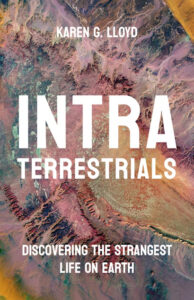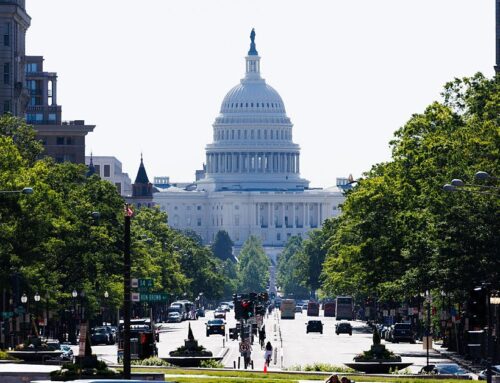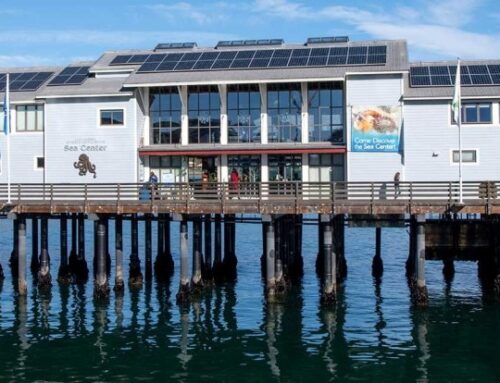A Volatile Proposition: Exploring Life Inside Earth’s Most Extreme Environments
May 16, 2025
To study extremophiles, sometimes you have to try to become one yourself, which is not easy to do. As we will see, microbes have had the leisure of ~3.8 billion years to hone the art of feeling comfy in a violent volcanic crater. I, on the other hand, had to get my act together in less than twenty-four hours.
Poás volcano, located about fifty kilometers from San José, the capital of Costa Rica, is the product of many eruptions over geological time. Instead of coming to a pointy top, it has a massive, curved bowl, which stretches a mile across and a thousand feet deep. The heat of the volcano boils elemental sulfur, which is normally a chalky solid, into a delicate pudding, such that pure, yellow, goopy sulfur constantly gurgles out of the crater floor. At the crater’s center is a lake that is an eye-popping shade of turquoise. It gets its color from the sulfur globules and clay minerals that churn through its waters.
Poás’s crater lake is so beautiful that Costa Rica has made it a national park with educational displays and an overlook offering a gorgeous view from a safe distance. However, despite the allure of the Instagram-worthy lake, no one is allowed to hike down into the crater itself, even when the volcano is calm. The reason for this is that the whole thing might erupt, possibly without warning. And when Poás erupts, it doesn’t belch rivers of lava like some other volcanoes. No, it’s much more dangerous. Poás is what is called a phreatic volcano, which has a deep magma chamber, well away from sight, and when water trickles down into it, pressure builds up dangerously deep underneath the crater, like a mountain-sized pressure cooker. When the pressure reaches a breaking point, the whole mountain top explodes in an instant.
Despite all the reasons not to go, you have to hike down to the crater yourself and pick up the samples by hand.
What living thing could possibly enjoy this fuming lake of sulfuric acid that explodes every now and then? Given the difficulty of getting samples, we are not awash in data to answer this question. But what we do know gives us the implausible answer that this volcano might have more life to offer than meets the eye. Poás is world-renowned for its thick sulfur deposits that are just itching to react with oxygen to release energy. However, the reaction is sluggish enough that the sulfur just kind of sits there for a while. This chemical environment is like money in the bank for microbes, as it provides abundant fuel for chemolithoautotrophy, so long as they can survive the unstable, highly acidic surroundings.
Microbes living in the crater lake are like real estate developers who build beach houses right on the sand dunes of the hurricane-pummeled coastline of North Carolina. There’s a great chance their investment will be flattened, but they gamble that they’ll get many years of rental income before that happens. High risk, high reward. A similar temptation presents itself to a curious scientist who loves a challenge. If you want to know just how microbes cling to this unstable, hostile land, you have to put your skin in the game too. Despite all the reasons not to go, you have to hike down to the crater yourself and pick up the samples by hand.
This is just what I did in February 2017. Our team, which consisted of an unwieldy group of twenty-five scientists plus two separate film crews documenting our work, was spending two weeks driving around sampling hot springs all over northern Costa Rica. So far in the trip, we had weathered some dicey interactions with hot springs along the way and had made some arduous hikes through thick jungles to reach springs on the flanks of volcanoes. But nothing matched the potential danger of hiking into Poás.
Our colleagues at Observatorio Vulcanológico y Sismológico de Costa Rica (OVSICORI)—who take turns hiking down into Poás’s crater regularly to collect samples and monitor the threat level that the volcano poses to Costa Rica’s nearby capital city—were the ultimate authorities on who would be allowed into the crater. To limit the number of people who would be hurt if something went wrong, they whittled the crater-bound team down to the smallest number of people required to collect the samples, and only greenlit one of the film crews to go with us. The other film crew seemed relieved to stick to the wide-angle shots from the visitor center.
The night before we hiked into Poás, the outreach coordinator, Katie Pratt, and I were gearing up for the trek and chatting with Steve Turner, a seasoned volcanologist, about what to expect. At some point in our conversation, it became clear that Steve wouldn’t be joining us in the crater the following day. Katie and I were baffled as to why a volcanologist on our trip wouldn’t be going into the volcano. That’s when he said, “Oh, I have to go inside so many volcanoes for my job that I avoid it whenever I can, just to cut down on my exposure to risk.” Katie and I looked at each other like deer in headlights.
How much risk, exactly, were we taking on?! But it was too late to change our minds now, and neither of us wanted to miss this once-in-a-lifetime opportunity. Plus, the volcano had been really quiet for many months, so the chance of a safe journey was high. Nevertheless, the revelation that Steve wasn’t going with us flipped some sort of switch in our brains, and our demeanor grew solemn. For some unfathomable reason, Katie and I both started quietly sipping bottles of Gatorade. Did we think that proper hydration could prevent a volcanic eruption? Hard to say.
The morning of our descent into the crater was magical. Blue skies, a quiet volcano, and jittery scientists. Despite the geological hostility, I quite enjoyed the hike down. For the first tens of meters, we pushed through bright green broad-leafed shrubs. After that, it was all bare rock, rubble, and consolidated ash piles with rain-built sluices. I have hiked in the Appalachians, the Alps, the Rockies, the Adirondacks, and the Sierra Nevadas, but none of them were anything like the hike down into the crater of Poás. The descent was like scrambling down a parking lot retaining wall covered in broken beer bottles. Everywhere I looked was a sea of textured or glassy rocks. It had an industrial feel, as if the gravel had been piled up by bulldozers. If someone had told me, “Imagine yourself in nature,” this is probably the last landscape that would come to mind. But the stark ground I was navigating was just as natural as a babbling brook in a lush forest.
We finally made it to the bottom of the crater, but we hadn’t yet reached the lake, which was obscured by one last mound of basaltic shrapnel. Coming around the final bend, I was shocked by the blinding brightness of the lake, as well as how enormous it was. What had appeared as no more than a pretty blue bauble in the distance when we started hiking that morning had blossomed into a sprawling sea. To give a sense of the scale, our bodies on the shore of the lake were too small for our colleagues back at the visitor center to see. Just then the winds shifted, and I was hit with the full sensorial experience of Poás lake, which is technically called Laguna Caliente.
I was immediately reminded of 25 percent strength salad vinegar you can purchase in supermarkets in Germany. If you don’t water it down before you use it, your mouth will burn, your eyes will tear up, and if you catch enough of it in your nostrils, you may even gag from the hit of sharp acid. This is what it felt like to stand next to Laguna Caliente. Any interest I had in jumping in for a swim was immediately replaced by a desire to pat my respirator for comfort.
While my attention was entirely focused on the lake, my OVSICORI colleague Maarten de Moor trudged past me on the way to start taking gas samples and said, “Keep your feet moving so your boots don’t melt.” The ground I was standing on was 100°C. Then he came back and said, “But don’t move them around so much that you lose your footing. There’s nothing to stop you on this slope and you’ll slide into the lake.” For a moment, the perilous nature of the situation overwhelmed me: I was terrified, awestruck, and having one of the most transformative experiences of my life. But we had measurements to make and samples to collect. And we were in a hurry.
Along with my colleague Donato Giovannelli, a microbiologist at the University of Naples “Federico II,” I inched closer to the water’s edge to collect some samples. For being so dangerous, the lake appeared serene, lapping at the edges of the rocks like a small pond. But this illusion of benevolence evaporated when I dipped the pH meter into it. The meter read 0.85. To this day, this remains the most acidic reading I have taken in nature.
We were in the crater of an active volcano, and every extra minute we spent down there increased our chances of disaster.
Next, I needed to reach into the water with my gloved hand and fill up a giant syringe, so we could push the water through a filter that would catch the microbes—a treacherous endeavor, as the ground at the edge of the battery-acid lake was covered in slippery clay. Luckily, Donato’s years of rugby and my years as a cheerleader prepared us for just this moment: Donato bent low and locked arms with me while I leaned out over the lake and filled syringe after syringe with the toxic fluid.
The clay deposits at the edge threatened to send my feet flying at any moment, but they held firm. Surprisingly, the water wasn’t very hot. It was about 40°C. If it hadn’t been full of skin-melting acid, it would indeed have been perfect for a nice soak. We completed the tense sampling without incident and brought the water-filled syringes over to a relatively flat surface, where the ground was sub-boot-melting temperature, so we could start the long process of filtering out the microbes.
Pushing water full of clay and sulfur particles through a filter is no easy task. Normally, turbid water like this would take us forever to filter. Normally, our field guide, Carlos Ramírez, would ignore us while we were doing our work, so he could focus on the logistics of getting to the next site. Normally, it wouldn’t matter how long we sat at a site, cursing as we tried to squeeze the last drop of liquid through a clogged filter. But this was not a normal day. We were in the crater of an active volcano, and every extra minute we spent down there increased our chances of disaster.
Carlos grabbed one syringe in each hand, walked over to a flat rock and began using it as a base, so he could push the water through the tiny 0.2μm filters by bearing down on the plungers. As we worked, I thought that maybe it was a good time to ask him about our escape plan, in case an eruption did happen. He looked up brightly and said, “Yes, of course! I’m so glad you asked. The exit strategy is simple. If this crater starts erupting, you should turn toward it and enjoy the view…because it will be your last.”
It may sound like Carlos was being overly dramatic, but fifty-four days after we climbed out of that crater, Poás experienced its largest eruption since the 1960s. Jets of steam, rock, and acid shot kilometers into the air for two weeks straight. The plume was visible all the way from San José. Our colleagues from OVSICORI, who were, gratefully, safe and sound in their offices during the eruption, sent us the last moments that their webcams recorded before they were destroyed in the blast. As I watched these clips in disbelief, my eyes searched for the place where my feet had been nervously shifting on the scalding, unstable ground just a few weeks before, as that same ground exploded into a giant fountain. Steve’s decision to avoid the trip and minimize his risk of exposure seemed sensible in retrospect.
When the volcano calmed down a bit, a few of my colleagues ventured up to the long-closed visitor center and sent us eerie videos of the dust-covered viewing platform, enshrouded in a thick foggy smoke. It looked like an alien landscape compared to that clear day two months ago when I swung my legs over the rail of the overlook to begin my hike. When it was finally safe enough to send drones out to check on the lake, my colleagues discovered that it was gone, having vaporized in the eruption. Over the following months, the lake refilled with a mixture of deep volcanic waters and the steady input of rain for which Costa Rica is famous.
__________________________________
From Intraterrestrials: Discovering the Strangest Life on Earth by Karen G. Lloyd. Copyright © 2025. Available from Princeton University Press.
Search
RECENT PRESS RELEASES
Related Post



